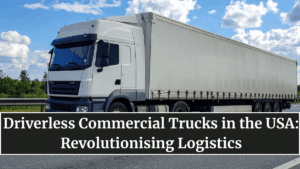The era of driverless commercial trucks is no longer science fiction — it’s the next big transformation in U.S. logistics. Autonomous heavy-duty vehicles are being tested on major freight routes across Texas, Arizona, and California, marking a shift that could redefine how goods move across America.
As the demand for faster, cheaper, and more efficient delivery surges, companies are turning to autonomous trucking to solve driver shortages, reduce costs, and improve safety. By 2025, the U.S. logistics industry is expected to witness the first wave of large-scale driverless truck operations.

Why the U.S. Logistics Sector Is Going Autonomous
The U.S. trucking industry moves nearly 72% of the nation’s freight, but it faces chronic issues like rising fuel prices, labor shortages, and high turnover rates.
Autonomous trucks promise to address these pain points through:
-
24/7 operations: No rest breaks or fatigue limitations, increasing productivity.
-
Fuel efficiency: AI algorithms optimize routes and driving behavior for better mileage.
-
Cost reduction: Eliminates driver-related expenses that make up nearly 40% of trucking costs.
-
Safety: Removes risks linked to human error, responsible for over 90% of road accidents.
Together, these factors position autonomous trucking as a solution for both economic and operational efficiency in logistics.
Key Players Leading the Driverless Truck Revolution
Several companies are spearheading this transformation:
-
Aurora Innovation: Backed by Amazon, developing autonomous technology for Class 8 trucks with PACCAR and Volvo.
-
TuSimple: Testing driverless freight routes between Arizona and Texas with advanced L4 autonomy.
-
Kodiak Robotics: Focused on scalable driverless solutions for long-haul freight.
-
Einride: Operating remote-controlled electric trucks for short-distance deliveries.
-
Waymo Via: Expanding its autonomous freight network with logistics partners across the Southwest.
These players are partnering with logistics giants like UPS, FedEx, and Ryder, signaling strong commercial interest in real-world deployment.
The Technology Powering Driverless Freight
Autonomous trucks use a blend of hardware and software to navigate safely and efficiently.
Core technologies include:
-
LiDAR and radar sensors: Provide real-time 360° environmental awareness.
-
High-definition mapping: Enables precise positioning within inches of accuracy.
-
AI perception systems: Detect and classify vehicles, pedestrians, and road conditions instantly.
-
V2X communication: Connects trucks to infrastructure and other vehicles for coordinated movement.
-
Redundant safety systems: Backup hardware ensures continued control in case of malfunction.
Together, these systems form a multi-layered safety net, allowing trucks to handle complex scenarios with minimal human input.
Benefits to the U.S. Supply Chain
The introduction of autonomous commercial trucks will bring significant benefits:
-
Reduced logistics costs: Freight companies could save up to $125 billion annually through automation.
-
Faster delivery times: Continuous operation eliminates human rest schedules.
-
Improved road safety: Advanced sensors and AI reduce accident rates.
-
Lower emissions: Optimized driving patterns improve fuel economy and enable smoother EV integration.
-
Economic resilience: Helps offset the current shortage of over 80,000 truck drivers nationwide.
As automation expands, the logistics industry could become smarter, cleaner, and more dependable than ever before.
Regulatory and Safety Challenges
Despite progress, several challenges are slowing full deployment:
-
Lack of federal standards: Regulations vary by state, making nationwide rollout complex.
-
Public trust: Many consumers remain skeptical about driverless trucks on highways.
-
Insurance and liability: Legal clarity on accident responsibility is still evolving.
-
Cybersecurity risks: Autonomous systems require robust defenses against hacking and tampering.
-
Infrastructure readiness: Current highways and depots need upgrades for automated operations.
Policymakers and industry leaders are now pushing for a federal framework to ensure uniform safety standards across all states.
The Road Ahead: Toward Full Autonomy
By 2026, most autonomous truck fleets will operate in Level 4 autonomy — meaning they can drive independently on mapped routes without human intervention. However, safety drivers will likely remain in some vehicles until technology and regulation mature.
Key future developments include:
-
Nationwide pilot corridors for freight testing.
-
Dedicated autonomous lanes on interstates.
-
AI-driven logistics management systems integrated with warehouses.
-
Electric autonomous trucks combining zero emissions with automation.
The shift from manual to machine-led trucking represents not just a technological milestone but a paradigm shift in American logistics.
The next decade will see highways filled with intelligent trucks that never tire, never text, and always optimize — redefining the meaning of freight efficiency.
FAQs
What are autonomous commercial trucks?
They are heavy-duty vehicles equipped with sensors and AI that allow them to navigate roads and deliver cargo with little or no human input.
Which companies are leading the driverless trucking industry?
Aurora, TuSimple, Waymo Via, Kodiak Robotics, and Einride are among the key players testing autonomous freight in the U.S.
How safe are driverless trucks?
They use advanced LiDAR, radar, and AI perception systems to detect and avoid obstacles, making them potentially safer than human drivers.
Are autonomous trucks legal on U.S. roads?
Yes, in several states like Texas, Arizona, and Nevada, driverless truck testing and limited operations are permitted under strict safety conditions.
When will autonomous trucks become common?
By 2026–2028, large-scale commercial deployment is expected across key freight corridors, particularly in the southern U.S.
Click here to know more.
